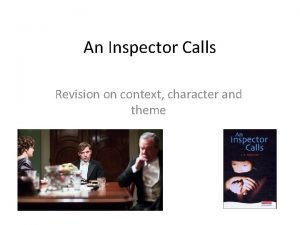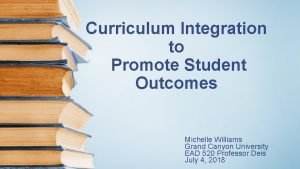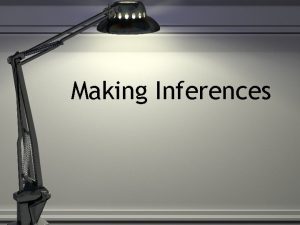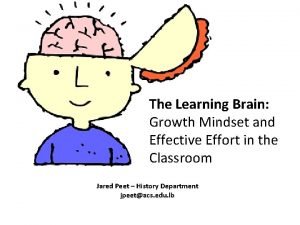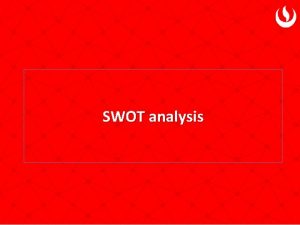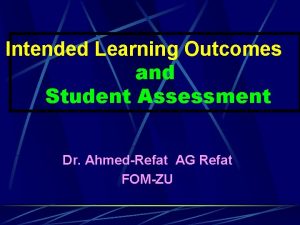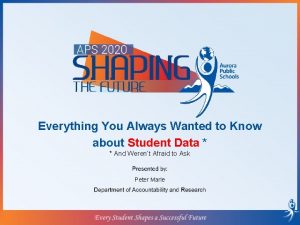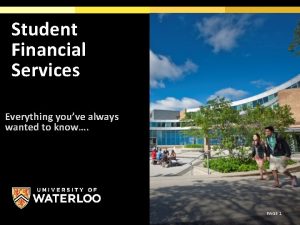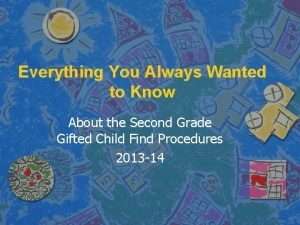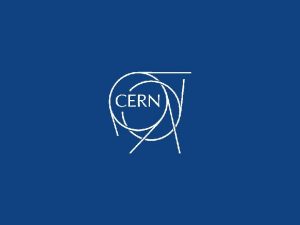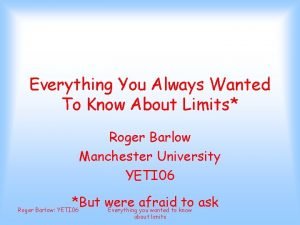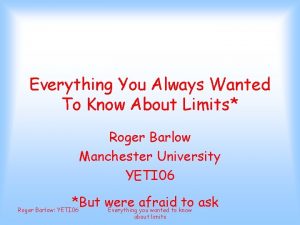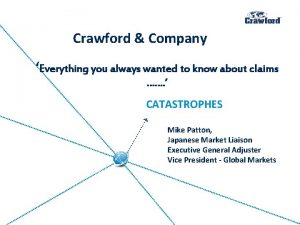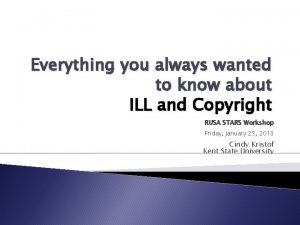Student Learning Outcomes Everything You Always Wanted to

























- Slides: 25

Student Learning Outcomes: Everything You Always Wanted to Know (but Were Afraid to Ask) Randy Beach, ASCC South Representative Jarek Janio, ASCCC Accreditation Committee, Santa Ana College Lisa Marchand, ASCCC Accreditation Committee, Cosumnes River College Accreditation Institute 2017 March 17 -18, Napa, CA

Before We Begin… SLOs? SLO’s SL O’ s Flocks of Birds: Recognizing Attitudes, Beliefs, and Practices

SLO’s in ACCJC Standards: 2002 to the Present • 2002 ACCJC Standards • Introduced “emphasis on student learning outcomes and assessment” • Required use of “student learning results in planning in decision-making across the institution. ” • 2007 “Rubric for Evaluating Institutional Effectiveness” • Structured Accreditation Teams assessment of the degree to which institutions met the practices described in the standards. • Exemplified and put labels on a continuum of stages of development toward and at compliance with the standards: “awareness, ” “development, ” “proficiency, ” and “continuous quality improvement. ” • All institutions were informed that they would be expected to be at “proficiency” by 2012. • 2012 -13 “College Status Report on SLO Implementation” • From this point forward colleges “were expected to demonstrate compliance with the Standards in the area of student learning outcomes. • 2014 SLO Evaluation Conducted with the Standards • Integrated, holistic evaluation of institutional effectiveness and academic quality in all regards

Shifting the Paradigm away from Compliance January 2017: Excerpts from Characteristics of Evidence, ACCJC Assessment data are used to organize institutional processes, analyze student learning gaps and implement strategies, allocate resources, and continuously evaluate the efficacy of the institution’s efforts to support and improve student learning”; • SLO results are used by students as they progress through their programs of study…

SLOs are Academic Research to Close the Loop Put into program review as an Action Plan Include data analysis in program review Create a narrative justifying resource requests based on your data analysis Outcomes data are the voices of students in your planning

SLO Data Action Resources ENGL 71 SLO “Identify and correct writing errors to achieve greater sentencelevel clarity in their own writing. ” 65% of students assessed nonproficient Increase student proficiency in SLO by 10% by fall 2019 by implementing a Power Study tutoring program for all ENGL 71 sections by Fall 2017 Approximately $20, 000 funding annually for 20 Power Study tutors to support the ENGL 71 program beginning Fall 2017 Implement Hire and assign tutors by fall 2017 Assess Measure SLO every semester beginning FA 17 to SP 19. Analyze results in Fall 2019 program review. Describe outcome and recommen dations

Do SLO’s belong on a syllabus? The Role of SLO’s in Students’ Autonomous Learning Lisa Marchand, Cosumnes River College Accreditation Institute 2017 February 17 -18, Napa, CA

Many students believe… learning happens at school. a good grade comes from doing all the assignments, answering questions correctly…(and from the teacher) the primary avenue to successful learning is memorization. answers to all questions can be found, fully formed, in the book. learning means that teachers and books transfer knowledge to students.

The Starting Point for Every Course Reorder these teaching and learning factors so they make sense to you: • Method for Calculating Student Grades • Topics of Instruction • Student Learning Outcomes • Homework Assignments • Tests and other Assessments

How can you communicate to students what they need to do to get an ‘A’? Guide students toward becoming their own best teacher: • Consciously design or select assignments that have relevance toward building or demonstrating SLO attainment. • Align everything that is done in class to the course SLO’s. • Give students practice in relating what they are doing to their progress toward attaining the course SLO’s. • Assign grades on the basis of what a student can do rather than upon what the student has done.

Align Course syllabi to Course SLO’s Example from a Pronunciation Course Student Learning Outcomes Instructional Activities #1 Differentiate between English and non. English sounds Listen to your own accent to identify pronunciation problems Assessments Vocal recordings: The teacher will compare her observations to your comments about your English pronunciation. Quiz: Watch the speaker’s face and -Learn about the organs of speech, kinds of speech sounds, and choose the written form of the word identify some sounds how these sounds are produced in the human vocal tract that matches movements the speaker and/or words by makes. observing a speaker's -Practice “lip reading” with partners in class visible organs of speech -Use a mirror to learn where articulation errors are affecting your Speaking projects English pronunciation Interviews with the professor - Learn the International Phonetic Alphabet sound/symbol system list the sounds of English that do not - Work with classmates from the same language background to Quiz: Describe the English sounds occur in the phonemic determine the phonemic inventory of your primary language that are difficult for you and explain inventory of the home why -Compare the phonemic inventory of your primary language with language that of Standard American English

Example from a Reading Course Student Learning Outcomes Instructional Activities SLO #1: EMPLOY "TOP-DOWN" COMPREHENSION STRATEGIES use context clues and structural analysis as aids to understanding word meanings. infer meaning through application of previous knowledge. identify implied ideas in level appropriate texts. Lecture Textbook assignments Extensive Reading Assignments SLO #2: DEMONSTRATE EXPLICIT COMPREHENSION OF LEVELAPPROPRIATE TEXTS recognize main ideas in intermediate level reading passages. locate topics and major supporting details of assigned readings. discuss and write responses to ideas from both fiction and non fiction readings. answer literal comprehension and vocabulary-in-context questions after assigned readings. SLO #3: DISTINGUISH THE MEANINGS CONVEYED BY FUNDAMENTAL ENGLISH GRAMMAR STRUCTURES recognize parts of speech from word forms and sentence structure. analyze sentences for their component parts and recognize the effect of word order on meaning. Assessments Quizzes Lecture Textbook assignments Reading: A Long Walk to Water Lecture In-class practice Textbook assignments Vocabulary Journal Quizzes Worksheets on A Long Walk to Water Vocabulary Journal Quiz

Sample Scoring Rubric for an Assignment Followed Directions The outline was complete and The assignment was Some aspect of the well detailed; there completed, but the writer did assignment did not meet the were FOUR or more sources; some parts of the task less criteria for a level 4 grade. sources were properly cited. successfully. The Outline will be Useful Although the outline was The organization of ideas and generally complete, it was not level of detail will guide the detailed enough or organized writer to write 14 or more well sufficiently to meet the developed paragraphs criteria for a level 4 grade. English is Good English was adequate; The work is original, and There were some errors in English errors were however parts of the outline phrasing, word choice, word English; however, the reader serious and made it were not clear enough for the forms, and spelling are all could still understand the difficult or impossible for reader to understand how the acceptable. meaning. the reader to understand. paper will be written. Sources are Properly Cited Overall Score The writer outlined all sections of the paper; however, there was insufficient detail in some parts of the outline. Directions were not followed. There was insufficient detail (development of ideas) for the outline to guide the writer. The works cited page is properly formatted. There were fewer sources than expected, OR the citations were in some way flawed. There were too few sources, OR the citations were not formatted correctly. The sources were not cited. Level 4 Level 3 Level 2 Level 1

e Material Practiced and Read by the Speaker Sample Scoring Rubric for Competencies Skill Score Level 1 Score Level 2 Score Level 3 Score Level 4 More than three consonant Two or more consonant sounds are always outside of the recognizable range for the target place and Consonant sounds are clear and manner. Consonant sounds are all within the manner. Some sounds are generally recognizable, although Articulation Some sounds are regularly ranges recognizable for the target occasionally deleted in there is inconsistent control. A SLO #1 deleted in certain place and manner. There are no certain environments. sound might occasionally be environments. More than sound deletions or substitutions. Some consonant sounds deleted in certain environments. one consonant sound is are sometimes avoided by deletion or substitution of a different sound. Two or more vowel sounds Vowel sounds are generally Vowel sounds are clear and within Vowels are always mispronounced. are often mispronounced. within the range identifiable by native including The speaker does not The speaker demonstrates reductions and native speakers. demonstrate ability to some ability to recognize deletions Vowels are usually appropriately Vowels are appropriately reduced in recognize where vowel reductions are SLO #1 reduced in unstressed syllables. reductions are required, but is inconsistent. Speaker frequently Speaker sometimes Speaker utilizes both primary Speaker consistently utilizes both Syllable Stress misplaces the stress in and secondary stress primary and secondary stress SLO #2 multisyllabic words. appropriately most of the time. appropriately. All words are given full Speaker sometimes fails to Speaker usually differentiates Speaker consistently differentiates Sentence Level pronunciation. There is no differentiate between Stress differentiation between content and function words SLO #2 content and function words in sentences. Use of emphatic stress is Emphatic stress is used to clarify the practiced and appropriate, but Has practiced and uses meaning of the passage. Speech is not always natural. Sometimes Stress for Does not use stress to stress after correction, but fluent, and natural. misses opportunities to Emphasis emphasize the meaning of often misses opportunities emphasize the meaning of the SLO #2 the passage. to emphasize the meaning passage. of the passage.

Skill Question Intonation SLO #3 Phrasing (Thought Groups) SLO #3 Score Level 1 Score Level 2 Uses rising intonation on Y/N Intonation missing or questions, and falling inappropriate. intonation on WH questions, but only when concentrating. Thought groups are sometimes bracketed by the Material is read word-byspeaker’s use of intonation, word. Punctuation may be breath, and/or pausing. reflected in speech, but Speakers at this level are grammatical phrases are not sometimes unable to bracketed by intonation or recognize the elements of a pausing. “thought group” and mistakes can impair the listener’s understanding. Intonation patterns for special purposes Not used. SLO #3 Not ever used effectively Score Level 3 Score Level 4 Uses rising intonation on Y/N Effortlessly uses rising intonation on questions, and falling intonation on Y/N questions, and falling intonation on WH questions, although there may WH questions. be an occasional mistake. Thought groups are generally bracketed by the speaker’s appropriate use of intonation, breath, and/or pausing. Thought groups are consistently bracketed by the speaker’s appropriate use of intonation, breath, and/or pausing. Pitch is manipulated purposefully to May be attempted, but with uneven create differences between characters results. in dialogue. The effect is expressive and entertaining. The speaker demonstrates awareness that there are The speaker demonstrates The speaker is unable to certain changes in phonemes awareness and some control of consistently recognize when that occur as a result of the changes in phonemes that occur Connected linking, sound deletion, and environment in which they as a result of the environment in Speech sounds conditioned by occur. However, linking, which they occur. Linking, sound SLO #4 adjoining segments are sound deletion, and sounds conditioned necessary. conditioned by adjoining segments are often missed or used. uttered incorrectly. Speech is somewhat difficult Speech is very difficult to to understand. Errors in Overall understand. Frequent errors Speech is mostly fluent and production sometimes lead to Characteristics of in production cause understandable and, in some misunderstanding. Speech is speech at the misunderstanding. Speech is parts, expressive. Errors in often discontinuous (choppy), level disconnected, and there is no production occur, but are rarely although there will be some CAPSTONE indication that the speaker is significant enough to interrupt indication that the speaker is PROJECT aware of the effects of understanding. Speaker will aware of the effects of PROFICIENCY sounds upon each other in occasionally self-correct mistakes. sounds upon each other in connected speech. The speaker demonstrates awareness and emerging control of changes in phonemes that occur as a result of the environment in which they occur. Linking, sound deletion, and sounds conditioned by adjoining segments are used appropriately. Speech is expressive and easy to understand. Errors in production occur, but are not significant enough to interrupt understanding. Speaker regularly notices and self-corrects mistakes.

Guided Self-Assessment What were the topics we covered last week? What did I learn that I can use in other situations? What are some examples of situations when this new knowledge will be useful? Which course learning outcome will these ideas help me achieve?

Formative Self-Assessment Week Three Name: TOPIC Previewing & Predicting Review of Sentence Structure SKILLS or MENTAL TOOLS PURPOSE and the RELATED SLO Teacher Feedback

Should SLO’s be in the Catalog? § The institution clearly describes its certificates and degrees in its catalog. § Student learning outcomes are included in descriptions of courses. § All course syllabi include student learning outcomes. § The institution has processes in place to verify that all students receive a syllabus, including student learning outcomes, for each course. From the January 2017 Guide to Evaluating and Improving Institutions

What about SLO’s and performance evaluations? § The evaluation of faculty, academic administrators, and other personnel directly responsible for student learning includes, as a component of that evaluation, consideration of how these employees use the results of the assessment of learning outcomes to improve teaching and learning. § The evaluation process leads faculty to improve teaching methods and plans to improve learning. § Evaluative instruments, where appropriate, include evidence of engagement with student learning outcomes. From the January 2017 Guide to Evaluating and Improving Institutions

10/25/2020 Accreditation Institute 2017 February 17 -18, Napa, CA Faculty Learning Community An ongoing systematic process in which faculty: • work collaboratively in recurring cycles of collective inquiry and action research to achieve better results for the students they serve. • operate under the assumption that the key to improved learning for students is continuous job-embedded learning for educators. • Research suggests that educational change is more likely to occur when leaders (a) create a supportive learning environment, (b) use data-driven decision making, (c) use a distributive style of leadership, and (d) function as a change agent (Ellmore, 2000).

10/25/2020 Accreditation Institute 2017 February 17 -18, Napa, CA Faculty Learning Community An ongoing systematic process in which faculty: • work collaboratively in recurring cycles of collective inquiry and action research to achieve better results for the students they serve. • operate under the assumption that the key to improved learning for students is continuous job-embedded learning for educators. • Research suggests that educational change is more likely to occur when leaders (a) create a supportive learning environment, (b) use data-driven decision making, (c) use a distributive style of leadership, and (d) function as a change agent (Ellmore, 2000).

Accreditation Institute 2017 February 17 -18, Napa, CA 10/25/2020

Final Questions

Closing Shout-Out… take-away sound bites • What’s one thing you had never occurred to you before? • What is something you will put to use in your work? • Who are you going to tell about what you heard this morning? • If your attitudes or beliefs about SLO’s have shifted, tell us how! • What do you still need to understand more clearly about SLO’s?

RESOURCES ACCJC Guide to Evaluating Institutions, revised Jan. 2017
 Context in an inspector calls
Context in an inspector calls What is ncbts
What is ncbts Domain 5 assessment and reporting example
Domain 5 assessment and reporting example Jesus you are lord
Jesus you are lord Sls student learning space login
Sls student learning space login Curriculum integration to promote student outcomes
Curriculum integration to promote student outcomes Always low prices
Always low prices How did you ... your last weekend?
How did you ... your last weekend? We ...... a big piece of wood last saturday. (see)
We ...... a big piece of wood last saturday. (see) When you infer, you always ________.
When you infer, you always ________. Jared peet
Jared peet Sandra templeton big fish
Sandra templeton big fish I will follow you wherever you ...........................
I will follow you wherever you ........................... Learning outcomes example
Learning outcomes example Learning outcomes of water cycle
Learning outcomes of water cycle Notice writing lesson plan
Notice writing lesson plan Swot analysis objectives
Swot analysis objectives Rhymes with understand
Rhymes with understand Example of learning objectives
Example of learning objectives Photosynthesis takes place in the
Photosynthesis takes place in the Learning outcomes of photosynthesis
Learning outcomes of photosynthesis Learning objectives of linear equations in one variable
Learning objectives of linear equations in one variable Learning outcome generator
Learning outcome generator Objectives of teaching direct and indirect speech
Objectives of teaching direct and indirect speech Purpose of learning outcomes
Purpose of learning outcomes What is the purpose of input and output devices
What is the purpose of input and output devices
